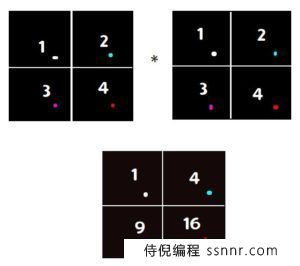NumPy.dot()与Python中’*’操作的区别
在Python中,如果我们有两个numpy数组,通常被称为一个向量。’*’运算符和numpy.dot()对它们的作用是不同的。特别是当你处理数据科学或竞争性编程问题时,知道这一点很重要。
*操作
*操作在数组元素上进行元素间的乘法。a[i][j]处的元素与b[i][j]相乘,这发生在数组的所有元素上。
示例:
Let the two 2D array are v1 and v2:- v1 = [[1, 2], [3, 4]] v2 = [[1, 2], [3, 4]] Output: [[1, 4] [9, 16]] From below picture it would be clear.

numpy.dot()
它进行正常的矩阵乘法。如果第一个数组的列数等于第二个数组的行数,那么只有numpy.dot()函数会被检查,否则会显示错误。
示例:
Let the two 2D array are v1 and v2:- v1=[[1, 2], [3, 4]] v2=[[1, 2], [3, 4]] Than numpy.dot(v1, v2) gives output of :- [[ 7 10] [15 22]]
示例 1:
import numpy as np
# vector v1 of dimension (2, 2)
v1 = np.array([[1, 2], [1, 2]])
# vector v2 of dimension (2, 2)
v2 = np.array([[1, 2], [1, 2]])
print("vector multiplication")
print(np.dot(v1, v2))
print("\nElementwise multiplication of two vector")
print(v1 * v2)
**Output :** vector multiplication [[3 6] [3 6]] Elementwise multiplication of two vector [[1 4] [1 4]]
示例 2:
import numpy as np
v1 = np.array([[1, 2, 3], [1, 2, 3], [1, 2, 3]])
v2 = np.array([[[1, 2, 3], [1, 2, 3], [1, 2, 3]]])
print("vector multiplication")
print(np.dot(v1, v2))
print("\nElementwise multiplication of two vector")
print(v1 * v2)
输出 :
vector multiplication [[ 6 12 18] [ 6 12 18] [ 6 12 18]] Elementwise multiplication of two vector [[1 4 9] [1 4 9] [1 4 9]]
版权声明:本页面内容旨在传播知识,为用户自行发布,若有侵权等问题请及时与本网联系,我们将第一时间处理。E-mail:284563525@qq.com




